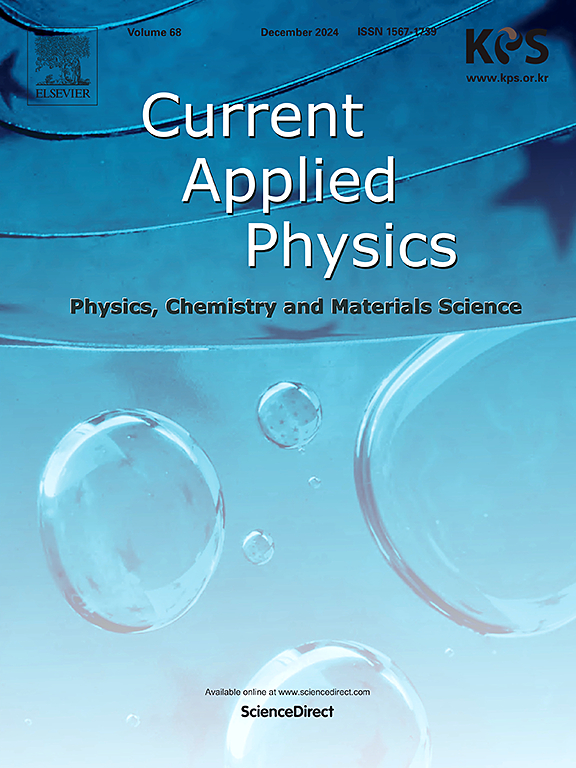Threshold shift mechanism in fluorine-doped indium-gallium-zinc-oxide thin film transistors via defect analysis
IF 3.1
4区 物理与天体物理
Q3 MATERIALS SCIENCE, MULTIDISCIPLINARY
引用次数: 0
Abstract
In this study, we systematically investigate the threshold voltage (Vth) shift mechanism in amorphous In-Ga-Zn-O (a-IGZO) thin-film transistors subjected to varying fluorine (F) implantation doses. Fluorine was implanted into a-IGZO at a dose of 1 × 1020 cm−3 with an implantation energy of 30 keV, resulting in a negative Vth shift compared to undoped samples. In contrast, higher doping concentrations (5 × 1020 and 1 × 1021 cm−3) induced positive Vth shifts.
To elucidate this mechanism, we conducted Current Transient Spectroscopy (CTS), X-ray Photoelectron Spectroscopy (XPS), and Reflection Electron Energy Loss Spectroscopy (REELS). The results indicate that moderate F doping shifts the Fermi level closer to the conduction band, causing a negative Vth shift. However, at higher doping levels, shallow defect states (D1) emerge, facilitating the recombination of conduction band electrons into these states. This process reduces the on-current (Ion) and leads to a positive Vth shift.
Fluorine doping enhances device stability against negative bias temperature instability (NBTI), while positive bias temperature instability (PBTI) degrades increasingly with higher doping. While our experiments did not encompass the full range of doping concentrations required for simultaneous optimization of both, our results suggest that lower fluorine doses may offer a balanced approach. Through direct defect characterization, this study clarifies the critical role of such defects in the threshold voltage shift mechanism of oxide thin-film transistors, providing valuable guidance for reliability improvements.
基于缺陷分析的氟掺杂铟镓锌氧化物薄膜晶体管的阈值移位机制
在这项研究中,我们系统地研究了不同氟(F)注入剂量下非晶In- ga - zn - o (a-IGZO)薄膜晶体管的阈值电压(Vth)移位机制。将氟以1 × 1020 cm−3的剂量注入到a- igzo中,注入能量为30 keV,与未掺杂样品相比,产生负的v移。相比之下,较高的掺杂浓度(5 × 1020和1 × 1021 cm−3)诱导了正的Vth位移。为了阐明这一机制,我们使用了电流瞬态光谱(CTS)、x射线光电子能谱(XPS)和反射电子能量损失光谱(REELS)。结果表明,适度的F掺杂使费米能级更靠近导带,造成负的Vth位移。然而,在较高的掺杂水平下,出现了浅缺陷态(D1),促进了导带电子在这些态中的重组。这一过程减少了导通电流(离子)并导致正的v值移位。氟掺杂增强了器件抗负偏置温度不稳定性(NBTI)的稳定性,而正偏置温度不稳定性(PBTI)随着掺杂量的增加而逐渐降低。虽然我们的实验没有涵盖同时优化两者所需的全部掺杂浓度,但我们的结果表明,较低的氟剂量可能提供一种平衡的方法。本研究通过直接缺陷表征,阐明了该类缺陷在氧化物薄膜晶体管阈值电压漂移机制中的关键作用,为提高可靠性提供了有价值的指导。
本文章由计算机程序翻译,如有差异,请以英文原文为准。
求助全文
约1分钟内获得全文
求助全文
来源期刊

Current Applied Physics
物理-材料科学:综合
CiteScore
4.80
自引率
0.00%
发文量
213
审稿时长
33 days
期刊介绍:
Current Applied Physics (Curr. Appl. Phys.) is a monthly published international journal covering all the fields of applied science investigating the physics of the advanced materials for future applications.
Other areas covered: Experimental and theoretical aspects of advanced materials and devices dealing with synthesis or structural chemistry, physical and electronic properties, photonics, engineering applications, and uniquely pertinent measurement or analytical techniques.
Current Applied Physics, published since 2001, covers physics, chemistry and materials science, including bio-materials, with their engineering aspects. It is a truly interdisciplinary journal opening a forum for scientists of all related fields, a unique point of the journal discriminating it from other worldwide and/or Pacific Rim applied physics journals.
Regular research papers, letters and review articles with contents meeting the scope of the journal will be considered for publication after peer review.
The Journal is owned by the Korean Physical Society.
 求助内容:
求助内容: 应助结果提醒方式:
应助结果提醒方式:


